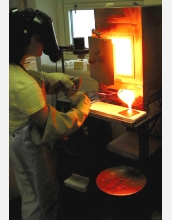Multimedia Gallery
Making phosphate glass to use with research
Amy Barnes, a National Science Foundation (NSF) fellow and graduate student in materials science, makes phosphate glass to use with her doctoral research. Phosphate glass is different from the glass that's in windows, which is built around sand or silica. Glass surfaces can substitute for mineral surfaces in experimental procedures. Barnes is a participant in the Pennsylvania State University's Biogeochemical Research Initiative for Education (BRIE) Program, which began in 1998 under a matching grant from NSF and Penn State.
More about this Image
Amy Barnes, a third year graduate student in materials science, arrived at Penn State on an NSF fellowship in materials science and engineering to work with world-renowned glass expert Carlo Pantano. Most of the glass making that she does is part of an undergraduate laboratory class that she helps Pantano teach, but she also makes phosphate glass to use with her doctoral research.
Barnes graduate work involves studying the interaction between microbes and minerals. She is particularly interested in how microbes obtain phosphorous from their surroundings, which they require to survive even though it is not readily available. Barnes is trying to find out how microbes bind to (or attack) minerals to get the nutrients they need.
Barnes research model is a simplified version of the mineral-microbe interaction. She substitutes phosphate glass for minerals found in nature. Barnes says using minerals from nature in her research is difficult because there's so much variability in their composition and you have no control over how they're made. This makes it hard to understand fundamental interactions at the surface. If you make glass in the lab, you can control what goes into it.
As a veteran BRIE student, Banes continues her own research and also assists with other BRIE classes, sharing what she's learned through the program to help other students succeed. (Year of image: 2002)
Credit: Photo by Caner Durucan; courtesy Amy Barnes
Images and other media in the National Science Foundation Multimedia Gallery are available for use in print and electronic material by NSF employees, members of the media, university staff, teachers and the general public. All media in the gallery are intended for personal, educational and nonprofit/non-commercial use only.
Images credited to the National Science Foundation, a federal agency, are in the public domain. The images were created by employees of the United States Government as part of their official duties or prepared by contractors as "works for hire" for NSF. You may freely use NSF-credited images and, at your discretion, credit NSF with a "Courtesy: National Science Foundation" notation.
Additional information about general usage can be found in Conditions.
Also Available:
Download the high-resolution JPG version of the image. (229 KB)
Use your mouse to right-click (Mac users may need to Ctrl-click) the link above and choose the option that will save the file or target to your computer.



